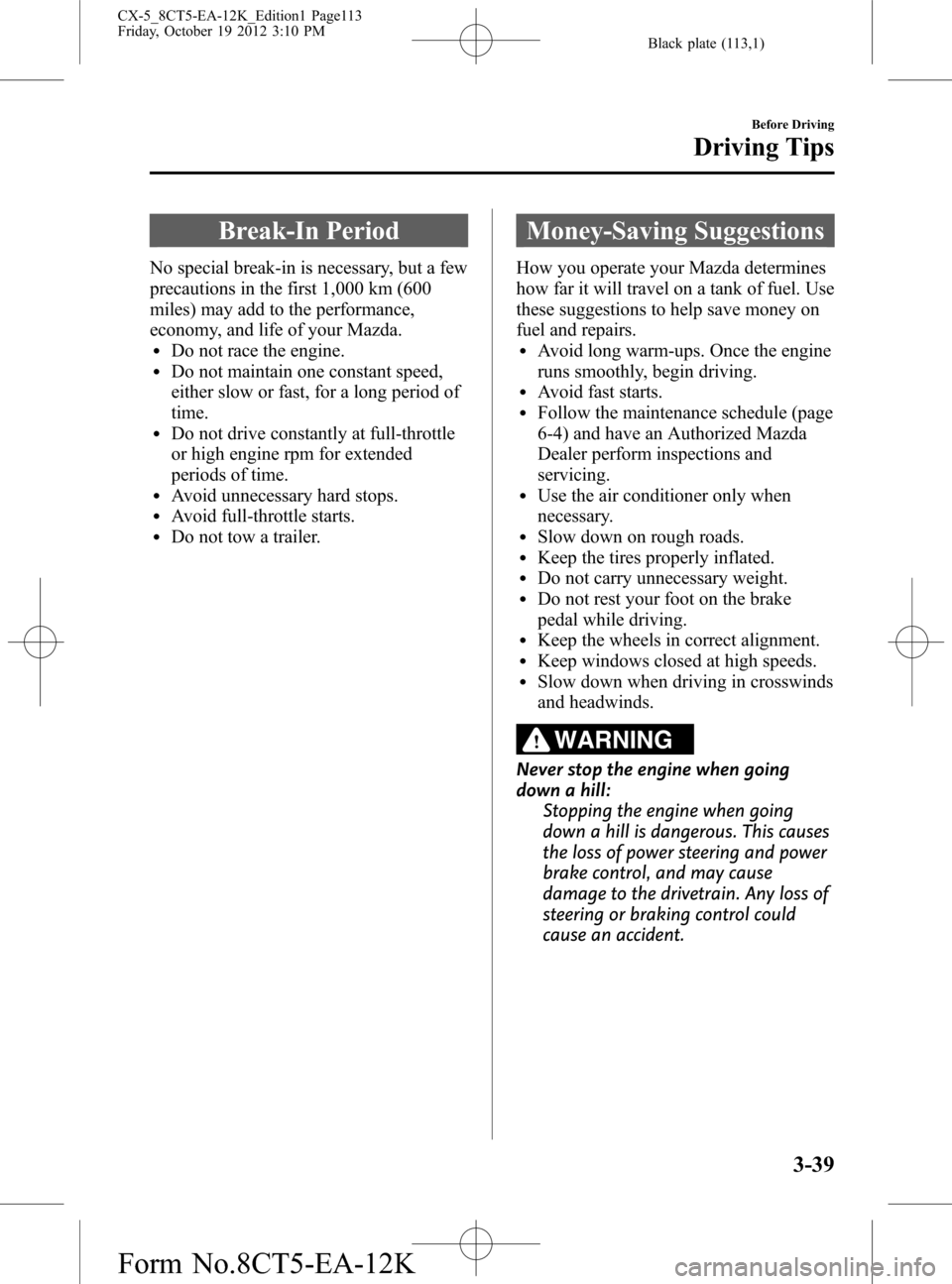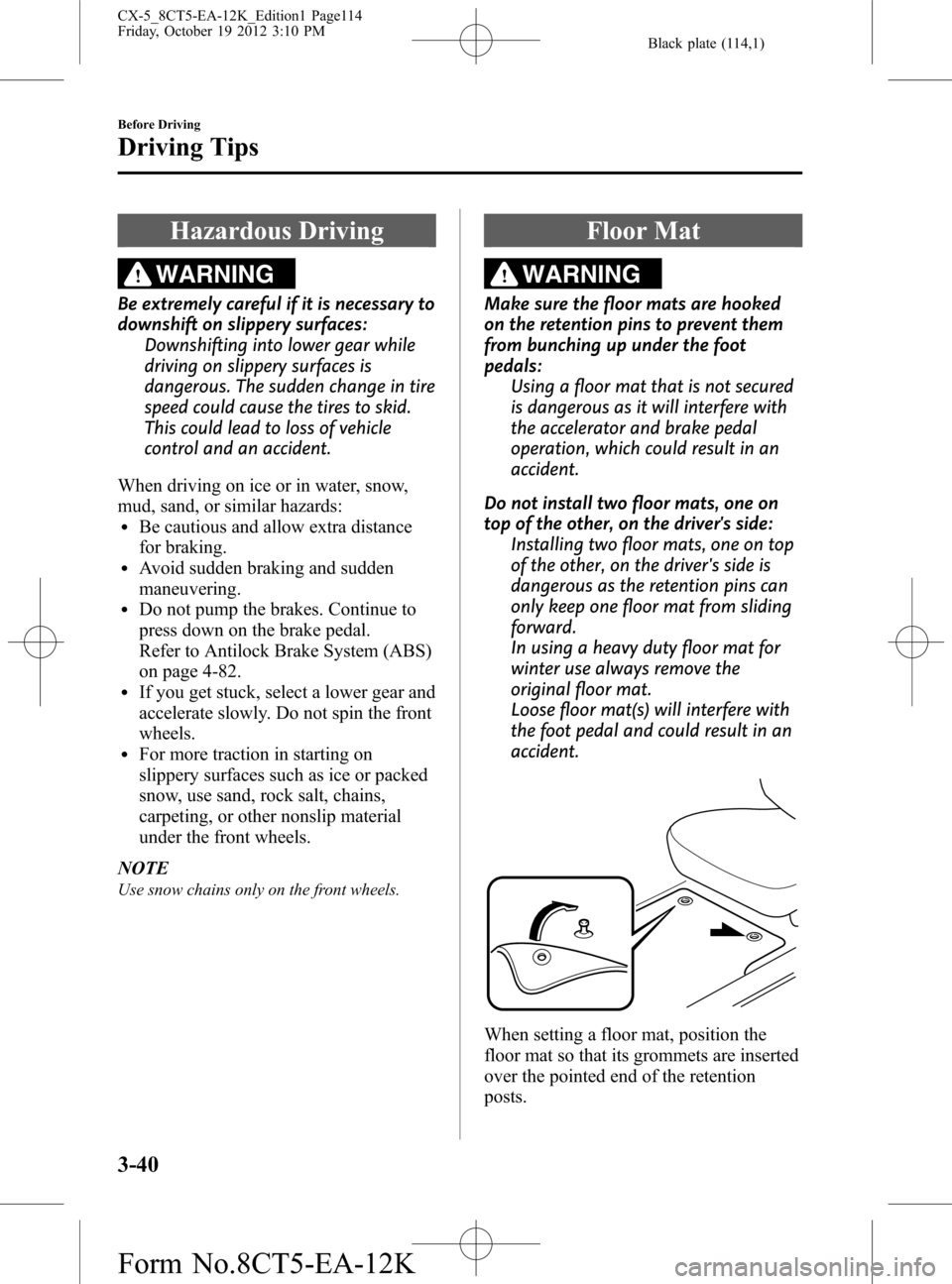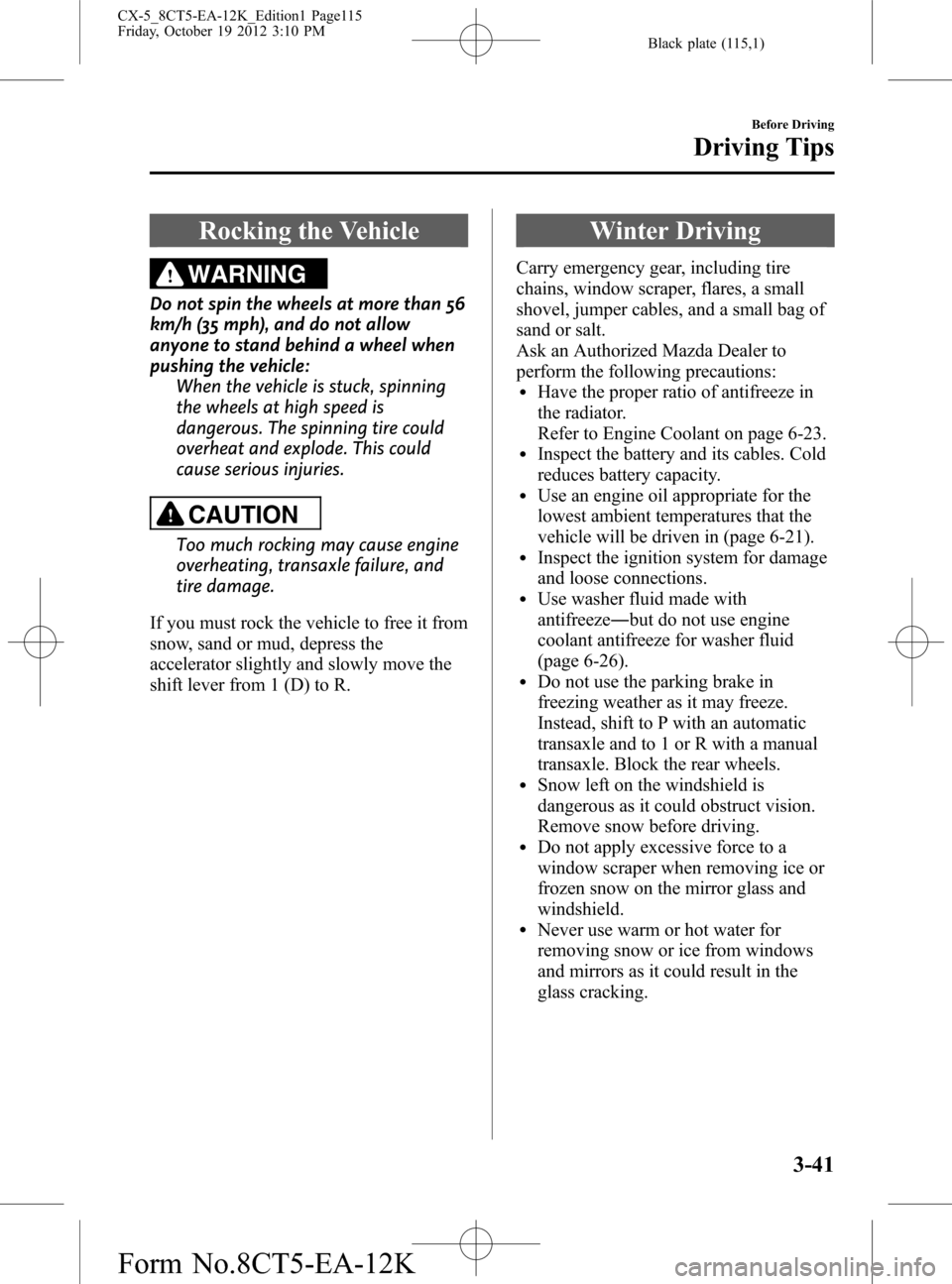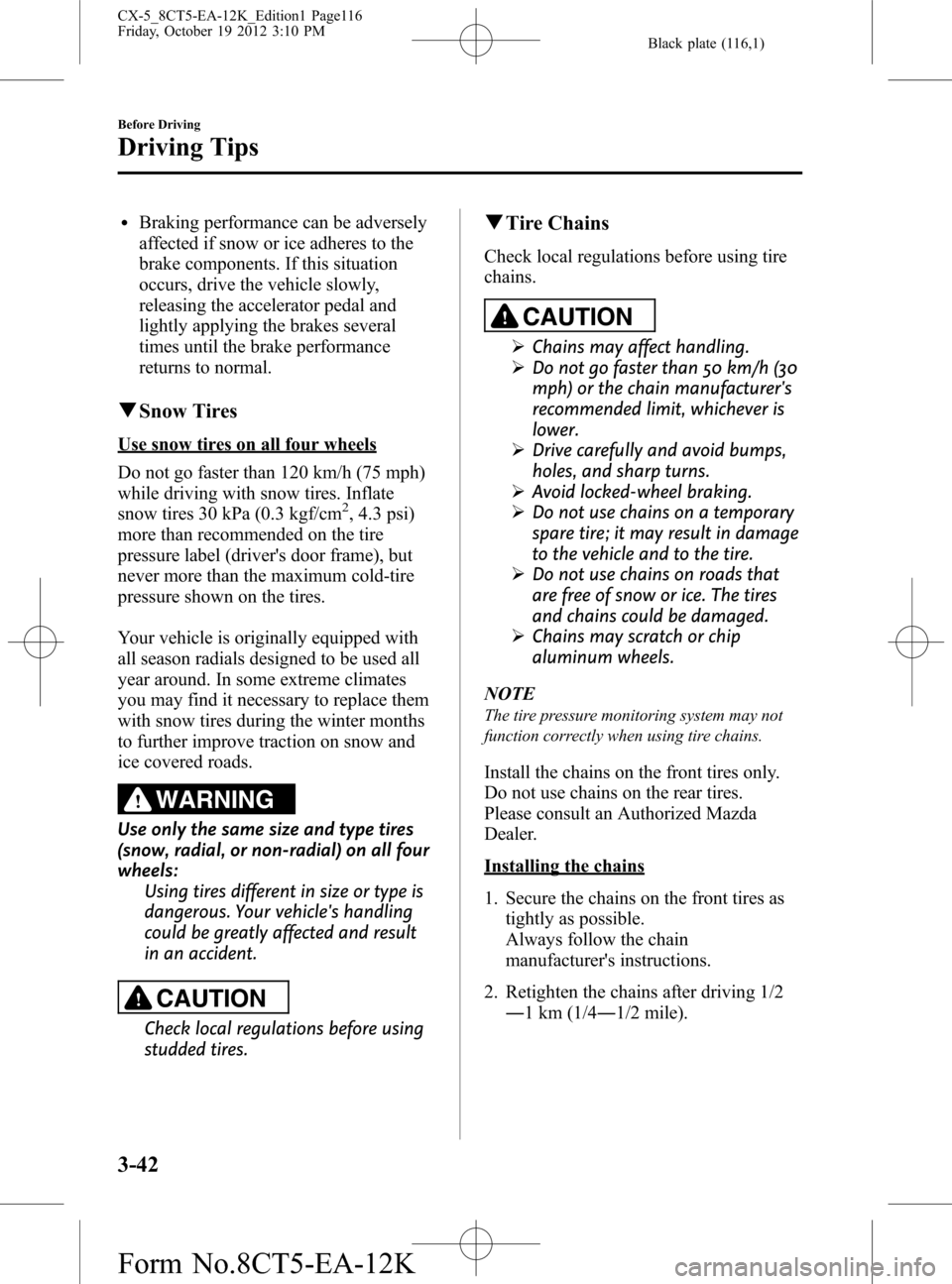MAZDA MODEL CX-5 2014 Owners Manual (in English)
Manufacturer: MAZDA, Model Year: 2014, Model line: MODEL CX-5, Model: MAZDA MODEL CX-5 2014Pages: 528, PDF Size: 7.97 MB
Page 111 of 528

Black plate (111,1)
Theft-Deterrent Systemí
If the theft deterrent system detects an
inappropriate entry into the vehicle, which
could result in the vehicle or its contents
being stolen, the alarm alerts the
surrounding area of an abnormality by
sounding the horn and flashing the hazard
warning lights.
The system will not function unless it's
properly armed. So when you leave the
vehicle, follow the arming procedure
correctly.
qOperation
System triggering conditions
The horn sounds intermittently and the
hazard warning lights flash for about 30
seconds when the system is triggered by
any one of the following:
lUnlocking a door with the door lock
switch or an inside door-lock knob.
lForcing open a door, the hood or the
liftgate.
lOpening the hood by operating the
hood release handle.
lSwitching the ignition ON without
using the push button start.
If the system is triggered again, the lights
and horn will activate until the driver's
door or the liftgate is unlocked with the
auxiliary key or with the transmitter.
(With advanced key)
The lights and horn can also be
deactivated by pressing the request switch
on a door.
NOTE
If the battery goes dead while the theft-
deterrent system is armed, the horn will
activate and the hazard warning lights will
flash when the battery is charged or replaced.
qHow to Arm the System
1. Close the windows and the moonroofí
securely.
2. Press the push button start off.
3. Make sure the hood, the doors, and the
liftgate are closed.
4. Press the lock button on the transmitter
or lock the driver's door from the
outside with the auxiliary key.
The hazard warning lights will flash
once.
The following method will also arm the
theft-deterrent system:
Press the door-lock switch“
”while
any door is open and then close all of
the doors.
(With the advanced keyless function)
Press a request switch.
The security indicator light in the
instrument panel flashes twice per
second for 20 seconds.
Refer to Warning/Indicator Lights on
page 4-22.
5. After 20 seconds, the system is fully
armed.
Before Driving
Security System
3-37íSome models. CX-5_8CT5-EA-12K_Edition1 Page111
Friday, October 19 2012 3:10 PM
Form No.8CT5-EA-12K
Page 112 of 528

Black plate (112,1)
NOTElThe theft deterrent system can also be
armed by activating the auto relock
function with all the doors, the liftgate and
the hood closed.
Refer to Transmitter on page 3-4.
lThe system will disarm if one of the
following operations takes place within 20
seconds after pressing the lock button:
lUnlocking a door.lAny door or the liftgate is opened.lThe hood is opened.lThe ignition is switched on.l(With the advanced keyless function)
Press the electric liftgate opener while
the key is being carried.
To rearm the system, do the arming
procedure again.
lWhen the doors are locked by pressing the
lock button on the transmitter or using the
auxiliary key while the theft-deterrent
system is armed, the hazard warning lights
will flash once to indicate that the system is
armed.
qTo Turn Off an Armed System
An armed system can be turned off using
any one of the following methods:
lUnlock the driver's door with the
auxiliary key.
lPress the unlock button on the
transmitter.
lSwitch the ignition ON.l(With the advanced keyless function)
Press a request switch on the doors.
The hazard warning lights will flash
twice.
NOTE
When the doors are unlocked by pressing the
unlock button on the transmitter or using the
auxiliary key while the theft-deterrent system is
turned off, the hazard warning lights will flash
twice to indicate that the system is turned off.
qTo Stop the Alarm
A triggered alarm can be turned off using
any one of the following methods:
lUnlock the driver's door with the
auxiliary key.
lPress the unlock button on the
transmitter.
lThe engine is started with the push
button start.
l(With the advanced keyless function)lPress a request switch on the doors.lPress the electric liftgate opener
while the key is being carried.
The hazard warning lights will flash
twice.
qTheft-Deterrent Labels
A label indicating that your vehicle is
equipped with a Theft-Deterrent System is
in the glove compartment.
Mazda recommends that you affix it to the
lower rear corner of a front door window.
3-38
Before Driving
Security System
CX-5_8CT5-EA-12K_Edition1 Page112
Friday, October 19 2012 3:10 PM
Form No.8CT5-EA-12K
Page 113 of 528

Black plate (113,1)
Break-In Period
No special break-in is necessary, but a few
precautions in the first 1,000 km (600
miles) may add to the performance,
economy, and life of your Mazda.
lDo not race the engine.lDo not maintain one constant speed,
either slow or fast, for a long period of
time.
lDo not drive constantly at full-throttle
or high engine rpm for extended
periods of time.
lAvoid unnecessary hard stops.lAvoid full-throttle starts.lDo not tow a trailer.
Money-Saving Suggestions
How you operate your Mazda determines
how far it will travel on a tank of fuel. Use
these suggestions to help save money on
fuel and repairs.
lAvoid long warm-ups. Once the engine
runs smoothly, begin driving.
lAvoid fast starts.lFollow the maintenance schedule (page
6-4) and have an Authorized Mazda
Dealer perform inspections and
servicing.
lUse the air conditioner only when
necessary.
lSlow down on rough roads.lKeep the tires properly inflated.lDo not carry unnecessary weight.lDo not rest your foot on the brake
pedal while driving.
lKeep the wheels in correct alignment.lKeep windows closed at high speeds.lSlow down when driving in crosswinds
and headwinds.
WARNING
Never stop the engine when going
down a hill:
Stopping the engine when going
down a hill is dangerous. This causes
the loss of power steering and power
brake control, and may cause
damage to the drivetrain. Any loss of
steering or braking control could
cause an accident.
Before Driving
Driving Tips
3-39
CX-5_8CT5-EA-12K_Edition1 Page113
Friday, October 19 2012 3:10 PM
Form No.8CT5-EA-12K
Page 114 of 528

Black plate (114,1)
Hazardous Driving
WARNING
Be extremely careful if it is necessary to
downshift on slippery surfaces:
Downshifting into lower gear while
driving on slippery surfaces is
dangerous. The sudden change in tire
speed could cause the tires to skid.
This could lead to loss of vehicle
control and an accident.
When driving on ice or in water, snow,
mud, sand, or similar hazards:
lBe cautious and allow extra distance
for braking.
lAvoid sudden braking and sudden
maneuvering.
lDo not pump the brakes. Continue to
press down on the brake pedal.
Refer to Antilock Brake System (ABS)
on page 4-82.
lIf you get stuck, select a lower gear and
accelerate slowly. Do not spin the front
wheels.
lFor more traction in starting on
slippery surfaces such as ice or packed
snow, use sand, rock salt, chains,
carpeting, or other nonslip material
under the front wheels.
NOTE
Use snow chains only on the front wheels.
Floor Mat
WARNING
Make sure the floor mats are hooked
on the retention pins to prevent them
from bunching up under the foot
pedals:
Using a floor mat that is not secured
is dangerous as it will interfere with
the accelerator and brake pedal
operation, which could result in an
accident.
Do not install two floor mats, one on
top of the other, on the driver's side:
Installing two floor mats, one on top
of the other, on the driver's side is
dangerous as the retention pins can
only keep one floor mat from sliding
forward.
In using a heavy duty floor mat for
winter use always remove the
original floor mat.
Loose floor mat(s) will interfere with
the foot pedal and could result in an
accident.
When setting a floor mat, position the
floor mat so that its grommets are inserted
over the pointed end of the retention
posts.
3-40
Before Driving
Driving Tips
CX-5_8CT5-EA-12K_Edition1 Page114
Friday, October 19 2012 3:10 PM
Form No.8CT5-EA-12K
Page 115 of 528

Black plate (115,1)
Rocking the Vehicle
WARNING
Do not spin the wheels at more than 56
km/h (35 mph), and do not allow
anyone to stand behind a wheel when
pushing the vehicle:
When the vehicle is stuck, spinning
the wheels at high speed is
dangerous. The spinning tire could
overheat and explode. This could
cause serious injuries.
CAUTION
Too much rocking may cause engine
overheating, transaxle failure, and
tire damage.
If you must rock the vehicle to free it from
snow, sand or mud, depress the
accelerator slightly and slowly move the
shift lever from 1 (D) to R.
Winter Driving
Carry emergency gear, including tire
chains, window scraper, flares, a small
shovel, jumper cables, and a small bag of
sand or salt.
Ask an Authorized Mazda Dealer to
perform the following precautions:
lHave the proper ratio of antifreeze in
the radiator.
Refer to Engine Coolant on page 6-23.
lInspect the battery and its cables. Cold
reduces battery capacity.
lUse an engine oil appropriate for the
lowest ambient temperatures that the
vehicle will be driven in (page 6-21).
lInspect the ignition system for damage
and loose connections.
lUse washer fluid made with
antifreeze―but do not use engine
coolant antifreeze for washer fluid
(page 6-26).
lDo not use the parking brake in
freezing weather as it may freeze.
Instead, shift to P with an automatic
transaxle and to 1 or R with a manual
transaxle. Block the rear wheels.
lSnow left on the windshield is
dangerous as it could obstruct vision.
Remove snow before driving.
lDo not apply excessive force to a
window scraper when removing ice or
frozen snow on the mirror glass and
windshield.
lNever use warm or hot water for
removing snow or ice from windows
and mirrors as it could result in the
glass cracking.
Before Driving
Driving Tips
3-41
CX-5_8CT5-EA-12K_Edition1 Page115
Friday, October 19 2012 3:10 PM
Form No.8CT5-EA-12K
Page 116 of 528

Black plate (116,1)
lBraking performance can be adversely
affected if snow or ice adheres to the
brake components. If this situation
occurs, drive the vehicle slowly,
releasing the accelerator pedal and
lightly applying the brakes several
times until the brake performance
returns to normal.
qSnow Tires
Use snow tires on all four wheels
Do not go faster than 120 km/h (75 mph)
while driving with snow tires. Inflate
snow tires 30 kPa (0.3 kgf/cm
2, 4.3 psi)
more than recommended on the tire
pressure label (driver's door frame), but
never more than the maximum cold-tire
pressure shown on the tires.
Your vehicle is originally equipped with
all season radials designed to be used all
year around. In some extreme climates
you may find it necessary to replace them
with snow tires during the winter months
to further improve traction on snow and
ice covered roads.
WARNING
Use only the same size and type tires
(snow, radial, or non-radial) on all four
wheels:
Using tires different in size or type is
dangerous. Your vehicle's handling
could be greatly affected and result
in an accident.
CAUTION
Check local regulations before using
studded tires.
qTire Chains
Check local regulations before using tire
chains.
CAUTION
ØChains may affect handling.
ØDo not go faster than 50 km/h (30
mph) or the chain manufacturer's
recommended limit, whichever is
lower.
ØDrive carefully and avoid bumps,
holes, and sharp turns.
ØAvoid locked-wheel braking.
ØDo not use chains on a temporary
spare tire; it may result in damage
to the vehicle and to the tire.
ØDo not use chains on roads that
are free of snow or ice. The tires
and chains could be damaged.
ØChains may scratch or chip
aluminum wheels.
NOTE
The tire pressure monitoring system may not
function correctly when using tire chains.
Install the chains on the front tires only.
Do not use chains on the rear tires.
Please consult an Authorized Mazda
Dealer.
Installing the chains
1. Secure the chains on the front tires as
tightly as possible.
Always follow the chain
manufacturer's instructions.
2. Retighten the chains after driving 1/2
―1 km (1/4―1/2 mile).
3-42
Before Driving
Driving Tips
CX-5_8CT5-EA-12K_Edition1 Page116
Friday, October 19 2012 3:10 PM
Form No.8CT5-EA-12K
Page 117 of 528

Black plate (117,1)
Driving In Flooded Area
WARNING
Dry off brakes that have become wet
by driving slowly, releasing the
accelerator pedal and lightly applying
the brakes several times until the brake
performance returns to normal:
Driving with wet brakes is
dangerous. Increased stopping
distance or the vehicle pulling to one
side when braking could result in a
serious accident. Light braking will
indicate whether the brakes have
been affected.
CAUTION
Do not drive the vehicle on flooded
roads as it could cause short
circuiting of electrical/electronic
parts, or engine damage or stalling
from water absorption. If the vehicle
has been immersed in water, consult
an Authorized Mazda Dealer.
Overloading
WARNING
Be careful not to overload your vehicle:
The gross axle weight rating (GAWR)
and the gross vehicle weight rating
(GVWR) of your vehicle are on the
Motor Vehicle Safety Standard Label
on the driver's door frame. Exceeding
these ratings can cause an accident
or vehicle damage. You can estimate
the weight of your load by weighing
the items (or people) before putting
them in the vehicle.
Before Driving
Driving Tips
3-43
CX-5_8CT5-EA-12K_Edition1 Page117
Friday, October 19 2012 3:10 PM
Form No.8CT5-EA-12K
Page 118 of 528

Black plate (118,1)
Driving on Uneven Road
Your vehicle's suspension and underbody can be damaged if driven on rough/uneven roads
or over speed bumps at excessive speeds. Use care and reduce speed when traveling on
rough/uneven roads or over speed bumps.
Use care not to damage the vehicle's underbody, bumpers or muffler(s) when driving under
the following conditions:
lAscending or descending a slope with a sharp transition anglelAscending or descending a driveway or trailer ramp with a sharp transition angle
Your vehicle is equipped with low profile tires allowing class-leading performance and
handling. As a result, the sidewall of the tires are very thin and the tires and wheels can be
damaged if driven through potholes or on rough/uneven roads at excessive speeds. Use
care and reduce speed when traveling on rough/uneven roads or through potholes.
3-44
Before Driving
Driving Tips
CX-5_8CT5-EA-12K_Edition1 Page118
Friday, October 19 2012 3:10 PM
Form No.8CT5-EA-12K
Page 119 of 528

Black plate (119,1)
Trailer Towing (U.S.A. and Canada)
Your Mazda was designed and built primarily to carry passengers and cargo.
If you tow a trailer, follow these instructions because driver and passenger safety depends
on proper equipment and safe driving habits. Towing a trailer will affect handling, braking,
durability, performance, and fuel economy.
Never overload vehicle or trailer. Consult an Authorized Mazda Dealer if you need further
details.
CAUTION
Do not tow a trailer during the first 1,000 km (600 miles) of your new Mazda. If you
do, you may damage the engine, transaxle, differential, wheel bearings, and other
power train components.
qWeight Limits
TTW and GCWR
The total trailer weight (TTW), gross combination weight rating (GCWR), gross axle
weight rating (GAWR), trailer load, and trailer tongue load must be within the
prescribed limits.
lThe total trailer weight (TTW) is the sum of the weights of the trailer load (trailer
weight plus cargo), trailer hitch, 2 passengers, and vehicle load (baggage, food,
camp gear, etc.). Never allow the total trailer weight (TTW) to exceed specifications
in the Trailer Towing-Load Table.
lThe maximum GCWR is the combination weight of the trailer and load plus the
towing vehicle (including trailer hitch, vehicle passengers, and load). It must not
exceed specifications in the load table.
GAWR and GVWR
Do not exceed front and rear GAWR (gross axle weight rating) and GVWR (gross vehicle
weight rating). If you do, vehicle handling, braking, and performance will be affected.
These values are also on the Motor Vehicle Safety Certification Label posted on the driver's
door frame.
High-altitude operation
In a high-altitude operating environment, a gasoline engine loses power at a rate of 3 % to
4 % per 304 m (1,000 ft) of elevation. In these conditions, a reduction in gross vehicle
weight and gross combination weight is recommended.
Before Driving
Towing
3-45
CX-5_8CT5-EA-12K_Edition1 Page119
Friday, October 19 2012 3:10 PM
Form No.8CT5-EA-12K
Page 120 of 528

Black plate (120,1)
TRAILER TOWING-LOAD TABLE
Because vehicle weights vary, adjustments must be made to meet the requirements in this
table.
ItemModel
SKYACTIV-G 2.0 SKYACTIV-G 2.5
2WD AWD 2WD AWD
Manual
transaxleAutomatic transaxle Automatic transaxle
MAX.
FRONTAL
AREA
2.97 m2(32 ft2)
MAX. TTW
907 kg (2,000 lb)
MAX. GCWR
2,577 kg
(5,637 lb)2,640 kg
(5,820 lb)2,708 kg
(5,970 lb)2,677 kg
(5,901 lb)2,747 kg
(6,056 lb)
MAX. GAWR
Front964 kg
(2,125 lb)1,001 kg
(2,207 lb)1,018 kg
(2,244 lb)1,027 kg
(2,264 lb)1,048 kg
(2,310 lb)
Rear966 kg
(2,130 lb)964 kg
(2,125 lb)1,015 kg
(2,238 lb)963 kg
(2,123 lb)1,013 kg
(2,233 lb)
MAX. GVWR
1,927 kg
(4,248 lb)1,962 kg
(4,325 lb)2,030 kg
(4,475 lb)1,987 kg
(4,381 lb)2,058 kg
(4,357 lb)
TRAILER-
TONGUE
LOADTongue load
Tongue load/Trailer load × 100 = 10 % to 15 %
Trailer load
DISTRIBU-
TION OF
TRAILER
LOADFront 60 %
Rear 40 %
3-46
Before Driving
Towing
CX-5_8CT5-EA-12K_Edition1 Page120
Friday, October 19 2012 3:10 PM
Form No.8CT5-EA-12K